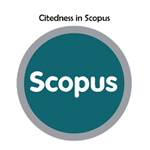Efektivitas Pemberian Gel Supernatan Bakteri Asam Laktat Terhadap Luas Luka Insisi pada Tikus Wistar
Abstract
Keywords
Full Text:
PDFReferences
Nugroho AA, Adianto C, Patria Y. (2020) Nano-Androcerum. Inovasi Wound Healing Gel dari Nanopartikel Daun Binahong dan Kayu Manis pada Luka Kronis. B I M F I. 7(1), 26-42.
Sen CK. (2021) Human Wound and Its Burden, Updated 2020 Compendium of Estimates. Adv Wound Care. 5(9), 281-292.
Singh S, Young A, McNaught CE. (2017) The physiology of wound healing. Surg (United Kingdom) [Internet]. 35(9), 473-487. Available from: http://dx.doi.org/10.1016/j.mpsur.2017.06.004.
Wintoko R, Dwi A, Yadika N. (2020) Manajemen Terkini Perawatan Luka Update Wound Care Management. JK Unila (e-Journal). 4, 183-189.
Zhao X, Li S, Ding J, Wei J, Tian P, Wei H. (2021) Combination of an engineered Lactococcus lactis expressing CXCL12 with light-emitting diode yellow light as a treatment for scalded skin in mice. Microb Technol (e-Journal). 14, 2090-100.
Id JK, Mierau I, Wirth T, Samaranayake H, Smith W. (2022) Four in one Combination therapy using live Lactococcus lactis expressing three therapeutic proteins for the treatment of chronic non- healing wounds. PLoS One. 1-26.
Ashraf R, Vasiljevic T, Day SL, Smith SC, Donkor ON. (2013) Lactic acid bacteria and probiotic organisms induce different cytokine profile and regulatory T cells mechanisms. J Funct Foods [Internet]. 1-15 Available from: http://dx.doi.org/10.1016/j.jff.2013.11.006.
Hasan AEZ, Artika IM, Abidin S. (2016) Produksi Asam Laktat dan Pola Pertumbuhan Bakteri Asam Laktat dengan Pemberian Dosis Rendah Propolis Trigona spp asal Pandeglang Indonesia. Curr Biochem. 1(3), 126-135.
Cappuccino JG, Welsh C. (2019) Microbiology : a Laboratory Manual. Student. New York: Pearson.
Hutkins RW. (2019) Microbiology and Technology of Fermented Foods. 2nd ed. USA: Wiley Blackwell.
Sinha A, Sagar S, Madhumathy M, Osborne WJ. (2019) Probiotic bacteria in wound healing; an in-vivo study. Iran J Biotechnol. 17(4), 11-15.
Dubey AK, Podia M, Priyanka, Raut S, Singh S, Pinnaka AK, et al. (2021) Insight Into the Beneficial Role of Lactiplantibacillus plantarum Supernatant Against Bacterial Infections, Oxidative Stress, and Wound Healing in A549 Cells and BALB/c Mice. Front Pharmacol. 12(11), 1-14.
Zahirović A, Plavec TV, Berlec A. (2022) Dual Functionalized Lactococcus lactis Shows Tumor Antigen Targeting and Cytokine Binding in Vitro. Front Bioeng Biotechnol. 10(1), 1-17.
Fuadi MI, Elfiah U, Misnawi. (2015) Jumlah Fibroblas pada Luka Bakar Derajat II pada Tikus dengan Pemberian Gel Ekstrak Etanol Biji Kakao dan Silver Sulfadiazine ( The Total Fibroblast on the Second Degree Burns of Rats after Treatment using Ethanolic Extract of Cocoa Beans ). Pustaka Kesehatan. 3(2),244-248.
Misfa O, Yuniati R, Prajoko YW. (2020) Effectiveness of Spirulina platensis Extract on Wound Area and TNF- α Levels on Blood : Experimental Studies In Wistar Rats Made Artificially by Vulnus Scissum and Infected by Staphylococcus aureus. Indonesian Journal Environmental Management and Sustain (e-Journal). 4, 55-58.
Nasution MFW, Yenita. (2021) Uji Efektivitas Madu Dibandingkan dengan Povidone Iodine terhadap Penyembuhan Luka Sayat pada Mencit (Mus Musculus). JIMKI (e-Journal). 8(3), 47-53.
Barzegari AA, Hashemzaei M, Alihemmati A, Soltani S, Naseri B. (2018) Effects of Lactobacillus rhamnosus (ATCC 7469) ointment on second-degree burn wound in Wistar rat. J Bas Res Med Sci (e-Journal). 5(1), 1-9.
Booney DR, Castenholz RW, Garrity GM. (2015) Lactococcus. Vol. 3. New York: Springer. 1-21.
Bigliardi PL, Abdul S, Alsagoff L, El-kafrawi HY, Pyon K, Tse C, et al. (2017) Povidone iodine in wound healing: A review of current concepts and practices. Int J Surg [Internet]. Available from: http://dx.doi.org/10.1016/j.ijsu.2017.06.073.
Saravanan P, Nanditaa PR, Kesav B, Singh R, Rupachandra KSS. (2023) Anti "‘ inflammatory and wound healing properties of lactic acid bacteria and its peptides. Folia Microbiol (Praha) [Internet]. Available from: https://doi.org/10.1007/s12223-022-01030-y.
Zurita-Turk M, Mendes Souza B, Prósperi De Castro C, Bastos Pereira V, Pecini Da Cunha V, Melo Preisser T, et al. (2020) Attenuation of intestinal inflammation in IL-10 deficient mice by a plasmid carrying Lactococcus lactis strain. BMC Biotechnol (e-Journal). 20(1), 1-12.
Sheskey PJ, Cook WG, Cable CG. (2017) Handbook of Pharmaceutical Excipients. 8th ed. Washington DC: Pharmaceutical Press; 2017.
Lu Y, Li H, Wang J, Yao M, Peng Y, Liu T, et al. (2021) Engineering Bacteria-Activated Multifunctionalized Hydrogel for Promoting Diabetic Wound Healing. vol. 31, Advanced Functional Materials.
Bakar A, Hilmi M, Halim AS, Jaafar H, Asiah AB, Hassan A. (2013) Chitosan Dermal Substitute and Chitosan Skin Substitute Contribute to Accelerated Full-Thickness Wound Healing in Irradiated Rats. Biomed Res Int [Internet]. Available from: http://dx.doi.org/10.1155/2013/795458.
Giusto G, Vercelli C, Comino F, Caramello V, Tursi M, Gandini M. (2017) A New, Easy-to-make Pectin-Honey Hydrogel Enhances Wound Healing in Rats. BMC Complement Altern Med. 17(266), 1-7.
Cai EZ, Ang CH, Raju A, Tan KB, Chor E, Hing H, et al. (2022) Creation of Consistent Burn Wounds : A Rat Model. Arch Plast Surg. 41, 317-324.
Lu YF, J Deng JW, Luo GX. (2020) Effects and mechanism of Lactococcus lactis thermo-sensitive hydrogel on the wound healing of full-thickness skin defects in diabetic mice. Chin J Burn [Internet]. 20(2), 1-23 Available from: https://www.yiigle.com/LinkIn.do?linkin_type=DOI&DOI=10.3760%2Fcma.j.cn501120-20201004-00427.
DOI: https://doi.org/10.37311/ijpe.v4i2.26011
Refbacks
- There are currently no refbacks.
Copyright (c) Olvaria Misfa, Atifa Aliyah Nur Rahmah, Eliya Mursyida

Indonesian Journal of Pharmaceutical Education is licensed under a Creative Commons Attribution-NonCommercial-ShareAlike 4.0 International License.



